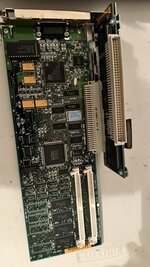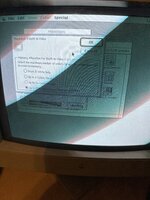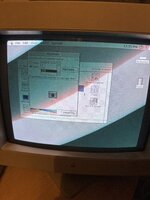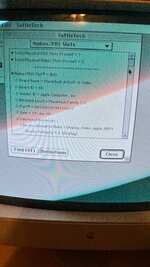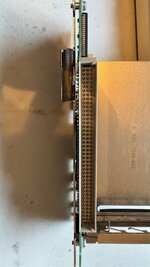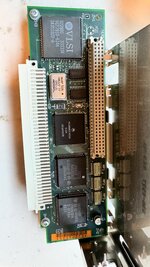I am trying to use nubus video card with adapter in my iisi. I do not get video when I connect to video card. Only the internal video works. I am testing this on 7.0.1. Is there anything I need to get this working?
-
Updated 2023-07-12: Hello, Guest! Welcome back, and be sure to check out this follow-up post about our outage a week or so ago.
You are using an out of date browser. It may not display this or other websites correctly.
You should upgrade or use an alternative browser.
You should upgrade or use an alternative browser.
Nubus video card in Iisi with adapter.
- Thread starter crazyben
- Start date
I have not recapped it. I will do it today. I tired with 2 different nubus video card that is working on iici and both are not working with adaptor. No bent pins or missing components. See attached pic if I missed anything.
Attachments
Recapped and still not getting video.I have not recapped it. I will do it today. I tired with 2 different nubus video card that is working on iici and both are not working with adaptor. No bent pins or missing components. See attached pic if I missed anything.
Anything else I can try? I even tried another iisi. Still nothing.There are electrolytic caps on the PDS->NuBus adapter which can go bad - they probably are at this point, as they are very old. Have you got other NuBus cards working with that
Phipli
Well-known member
Test if the 40MHz clock is working, otherwise, you're going to have to check every trace and chip. It's not the easiest to help with. All we have to go on is that it doesn't work. There isn't a whole lot we can do to help. Usually these things are due to a damaged trace or crusty pin on a chip so you can guess where it is by visually inspecting - but you need to look really closely - closer than we can in photos over the internet.Anything else I can try? I even tried another iisi. Still nothing.
Yeah I was struggling to know how to answer that, it could be anything but the oscillator is probably the most likely thing to fail on there.
Is anything getting overly hot, or on the other hand, is everything remaining stone cold on the adapter?
I assume you’ve checked the slot on the IIsi board itself works? Got any PDS cards you could try?
Is anything getting overly hot, or on the other hand, is everything remaining stone cold on the adapter?
I assume you’ve checked the slot on the IIsi board itself works? Got any PDS cards you could try?
Phipli
Well-known member
Not many options really. Probably an accelerator (processor upgrade). There aren't many others.Tattletech do not show adapter whatsoever. Any idea which PDS card can I test for this? I will have to see what PDS card I even have.
How would I go about testing the 40MHz.Test if the 40MHz clock is working, otherwise, you're going to have to check every trace and chip. It's not the easiest to help with. All we have to go on is that it doesn't work. There isn't a whole lot we can do to help. Usually these things are due to a damaged trace or crusty pin on a chip so you can guess where it is by visually inspecting - but you need to look really closely - closer than we can in photos over the internet.
Phipli
Well-known member
This would be perfect :How would I go about testing the 40MHz.
Otherwise, you could use a multimeter to measure voltage between the ground and the output pin. It isn't hugely helpful, but if you measure a voltage somewhere in the middle between 0 and 5v it means it is outputting something (although you can't tell what exactly).
Is there a guide on how to test this. Ready made kit. I am still learning so this kit sounds like super advanced to meThis would be perfect :
Otherwise, you could use a multimeter to measure voltage between the ground and the output pin. It isn't hugely helpful, but if you measure a voltage somewhere in the middle between 0 and 5v it means it is outputting something (although you can't tell what exactly).
Mk.558
Well-known member
You'd need an oscilloscope to do that. Most "decent" scopes are 200MHz scopes so that's not really a problem. You can also use a DMM but that basically will read an average if it's on the voltage setting (which basically will just tell you if it's working or not), if they have a Hz/Duty Cycle setting then it may not go up high enough. My DMMs apparently cap out at 10MHz.
For what you're doing, a DMM is probably "good enough". You'd just identify which pins are used on the oscillator, power it on, stick it on Voltage DC mode, and stick the two probes carefully to the two pins. You'll probably get something like 1V or something.
For PDS card, an ethernet card is a popular option. IIRC most IIsi will have 1 of the 3 following options in their PDS slot: NuBUS w/graphics card, Ethernet card + FPU installed w/accelerator, or Ethernet card + special graphics card (think Radius made one compatible).
That graphics card appears to be the 820-0400 Apple Display Card 4*8. Nothing fancy, poor thing doesn't even get acceleration.
P.S. The NuBUS adapter has only one 16v 10uF cap on it if i remember right.
edit: Having used a IIsi, the difference between internal graphics and a dedicated card isn't that much, particularly when the GFX card is unaccelerated. However, what would make a difference for sure would be 4 things: A) Having "enough" memory: imo 20-32MB is perfectly adequate for even the most severe tests of a 68030 machine and allows you a nice RAM disk; B) An Ethernet card; C) You can bump the disk Cache to above 1024K to force the system to address main memory for stuff rather than fighting over the 1MB on board with the internal graphics, and D) probably won't make much of a difference, but the IIsi can support a bump to 25MHz without much hassle at all. Most IIsi and SE/30 ethernet cards support an FPU, which, while won't make a big deal, does help when in certain situations.
For what you're doing, a DMM is probably "good enough". You'd just identify which pins are used on the oscillator, power it on, stick it on Voltage DC mode, and stick the two probes carefully to the two pins. You'll probably get something like 1V or something.
For PDS card, an ethernet card is a popular option. IIRC most IIsi will have 1 of the 3 following options in their PDS slot: NuBUS w/graphics card, Ethernet card + FPU installed w/accelerator, or Ethernet card + special graphics card (think Radius made one compatible).
That graphics card appears to be the 820-0400 Apple Display Card 4*8. Nothing fancy, poor thing doesn't even get acceleration.
P.S. The NuBUS adapter has only one 16v 10uF cap on it if i remember right.
edit: Having used a IIsi, the difference between internal graphics and a dedicated card isn't that much, particularly when the GFX card is unaccelerated. However, what would make a difference for sure would be 4 things: A) Having "enough" memory: imo 20-32MB is perfectly adequate for even the most severe tests of a 68030 machine and allows you a nice RAM disk; B) An Ethernet card; C) You can bump the disk Cache to above 1024K to force the system to address main memory for stuff rather than fighting over the 1MB on board with the internal graphics, and D) probably won't make much of a difference, but the IIsi can support a bump to 25MHz without much hassle at all. Most IIsi and SE/30 ethernet cards support an FPU, which, while won't make a big deal, does help when in certain situations.
Phipli
Well-known member
Hum, sorry, I thought I'd picked out a preassembled one.Is there a guide on how to test this. Ready made kit. I am still learning so this kit sounds like super advanced to me.
I'll see if I can see one.
Just casually mention these boards count up to 60MHz.
Phipli
Well-known member
Cheaper here, but still kits.

Got any friends that can solder? They're pretty easy to build, could get two, one for them, one for you.
Make sure you get the red one. The yellow one... I got the yellow one first time and it came with the wrong parts and didn't work.

1MHz-1.1GHz 1Hz-50MHz Crystal Oscillator Tester Frequency Counter Meter DIY Kits | eBay
1x DIY Kits(DIY kits, not assembled ). - Frequency range 1 Hz. 50 MHz. - Optional addition or subtraction of a frequency offset (programmable). - The display off if the frequency didn't change significantly within 15seconds.
www.ebay.com
Got any friends that can solder? They're pretty easy to build, could get two, one for them, one for you.
Make sure you get the red one. The yellow one... I got the yellow one first time and it came with the wrong parts and didn't work.
Similar threads
- Replies
- 6
- Views
- 417
- Replies
- 12
- Views
- 567
- Replies
- 6
- Views
- 605

